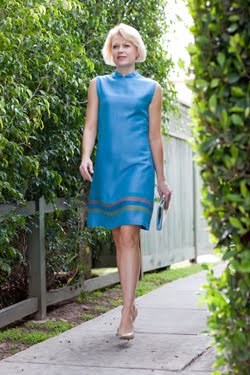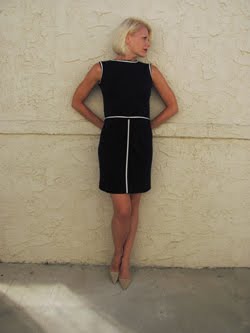To those who follow GlamAmor, it will come as no surprise that the style of film noir and the Hitchcock Heroine act as ongoing influences in fashion. Edith Head, costume designer extraordinaire best known for her work with Alfred Hitchcock, is a hero of mine and huge influence on my own style. Rear Window was an absolute vision to me (and many others) and Edith followed it with more iconic work such as To Catch a Thief, Vertigo, and The Birds. Edith and Hitchcock had a near perfect partnership for their similar visions of style--clean lines, tailored fit, and controlled pops of color. Though femininity was becoming much more overt and revealing in the 1950s, both felt that suggestions of sex should be subtle and left largely to the imagination.
The earlier style of film noir, too, is very close to my heart. Both the movies and their design influence on fashion have also been well documented here. In fact, several of The Style Essentials--the most iconic costume design that influenced fashion both then and now--are from the genre. Movies of the 1940s like Gilda, Mildred Pierce, and The Postman Always Rings Twice are regular references in design. In fact, film noir was already a strong trend in fashion a couple years ago--acting as inspiration for strong suiting in Fall 2011 before it appeared again in gowns for the 2012 Golden Globe red carpet.
For Fall 2013, both film noir and Hitchcock style are back again as trends and can be seen in collections that include Prada, Gucci, Bottega Veneta (below), Marc Jacobs, and Zac Posen. Even though they sometimes appear in slightly less literal translations this season, the style of the 1940s and 1950s is still quite apparent. It is the reason Elle Canada's Ava Baccari reached out to me to learn more about the origins of the classic cinema inspiration. I have reprinted Ava's article below, but included links within GlamAmor to learn even more about the history and films behind the style. You can also visit Elle Canada to read the original article in its entirety, where links will take you to examples of fabulous Fall 2013 fashion found within their site.
If you love learning about the HISTORY OF FASHION IN FILM, stay tuned--there will soon be an announcement of my 6 part webinar that will cover the most iconic and influential costume design from the 1920s to 1970s with their Cinema Connections to fashion today.
Film Noir Fashion: Fall Runway Trend Spotlight
Hitchcock blondes, pencil skirts, and stiletto heels—we explore the origin of film noir fashion (a.k.a femme fatale style), one of Fall 2013’s top runway trends by Ava Baccari
Film noir—the genre of sultry classic Hollywood crime dramas—has literally taken on a style of its own. This season, designers from Miuccia Prada to Marc Jacobs were influenced by the structured silhouettes (and blondes) of classic cinema. “It’s so immersed in our culture now people may not even know where the original references come from,” explains Kimberly Truhler, an L.A.-based film, costume design and fashion historian, about fashion’s love affair with film noir.
Truhler gave us a history lesson on the influence of classic cinema on fashion, and how film noir continues to inspire designers this fall.
Truhler gave us a history lesson on the influence of classic cinema on fashion, and how film noir continues to inspire designers this fall.
Film Noir Fashion: Origins in Classic Cinema
What exactly are we talking about when we talk about film noir?
“The ‘40s and ‘50s [provide] the bulk of the film noir genre,” says Truhler, citing French film critic Nino Frank who coined the term in 1946 to describe hard-boiled crime thrillers. In fact, World War II, was a major catalyst for a shift in fashion and costume design.
“Silk use in fashion was banned in 1942, so the shape and materials that you see in ‘40s clothing is about the structure,” explains Truhler. And since wool and cotton was largely available, in fashion, it naturally took shape as structured suiting. The strong-shouldered trend—seen at Gucci and Bottega Veneta’s Fall 2013 shows— can be traced back to Joan Crawford and the Hollywood costume designer fondly known as Adrian.
Joan Crawford in 1945's Mildred Pierce (above)
and suiting from Bottega Veneta Fall 2013
“As of 1920, with the film influence and influence of costume designers, we entered what I would consider the modern fashion era,” says Truhler. Take any of the Yves Saint Laurent-designed outfits worn by Catherine Deneuve in Belle de Jour—they maintain the same classic French chic-style as when the film debuted in 1967. For a not-so-subtle translation of an iconic outfit in the film, see the collared black dress from Valentino’s Fall 2013 collection (see below).
Catherine Deneuve in Yves Saint Laurent for 1967's Belle de Jour (above)
and Valentino's version for Fall 2013
Rita Hayworth in 1946's Gilda (above)
and an inspired gown in Zac Posen's Fall 2013 collection
Film Noir Fashion: Enter the Femme Fatale Era
“A lot of the women in film noir specifically were tough girls,” explains Truhler about the badass appeal of silver screen legends like Rita Hayworth and Veronica Lake. With the men overseas and limited availability of fabrics at the time, the attitude toward fashion was more, “‘I’m putting on my armor, I’ve got to go to work now, I’ve got to fight to survive.” The tougher silhouettes in clothing mirrored this social shift.
“It went from the end of the ‘30s—the silk charmeuse bias-cut gowns where women weren’t even wearing underwear anymore—to the ‘40s where you couldn’t even use those fabrics.”
Women at the time were naturally inspired by the onscreen wardrobes of Grace Kelly and Marlene Dietrich—and we still are today.
Film Noir Fashion: The rise of Hitchcock Heroine Style
Women at the time were naturally inspired by the onscreen wardrobes of Grace Kelly and Marlene Dietrich—and we still are today.
Veronica Lake in 1946's The Blue Dahlia (above)
and Gucci's Fall 2013 collection
“Hitchcock style is largely introverted sexuality,” says Truhler about the look of the distress-causing damsels in director Alfred Hitchcock’s canon that’s taken on a life of its own. The tailored aesthetic—pencil skirts, pearls, fitted skirtsuits—was perpetuated by costume designer Edith Head, who began working with Hitchcock on 1954’s Rear Window.
“The Hitchcock heroine has a very classic look, but there’s always a little wink-wink about sexuality in there,” explains Truhler. “[Hitchcock] doesn’t want sexuality out there for everyone to see—he wants people to really think about it, so it can seem a little buttoned-up here and there.”
Film Noir Fashion: On the Fall 2013 Runways
Film noir is everywhere this season, creeping up in well-tailored suiting (and classic Hitchcockian blonde hair) at Marc by Marc Jacobs, to structured, colourful coats at Bottega Veneta. “For fall, film noir seems to be a perennial, cyclical reference,” says Truhler. “In fall, you’re going to want more layers, more suits, and the emphasis is naturally more on structure, and how to make a woman look sexy covering up for the season—what a better reference than film noir?”
And while designers have previously translated the aesthetic in a more literal sense—the late Alexander McQueen’s Fall 2005 collection was an obvious homage to Hitchcock’s The Man Who Knew Too Much—this fall showed a looser interpretation. “Prada in particular, it is a bit deconstructed,” cites Truhler as a significant departure from Edith Head’s polished leading ladies. “It’s open, off the shoulder—it is that Hitchcock look if it was totally buttoned up.”
Prada included a somewhat deconstructed gray suit (below)
that could be a nod to Alfred Hitchcock's 1958 classic Vertigo
Prada's gingham suit for Fall 2013 (above)
seems inspired by Lauren Bacall's iconic gingham suit in 1944's To Have and Have Not
Film Noir Fashion: The Classic Fall Uniform
The thing about the film noir moniker in the fashion sense is recognizing that it’s not a return of the look but a longstanding tradition of designers taking inspiration from classic cinema. “It happens every single year,” says Truhler, drawing on the return on the art deco trend with 2011’s The Artist and ending this summer with Baz Lurhmann’s The Great Gatsby. “There are designers that particularly love classic cinema, like Ralph Lauren, Isaac Mizrahi, Tommy Hilfiger.”
Truhler doesn’t see the film noir trend ending any time soon, nor the well of cinematic inspiration running dry: “From a designer standpoint, classic cinema is the gift that just keeps on giving.”
































































































2 comments:
Wonderful interview and great photos. Film noir style really IS the "gift that keeps on giving"!
Thank you--so glad you enjoyed it!
Post a Comment